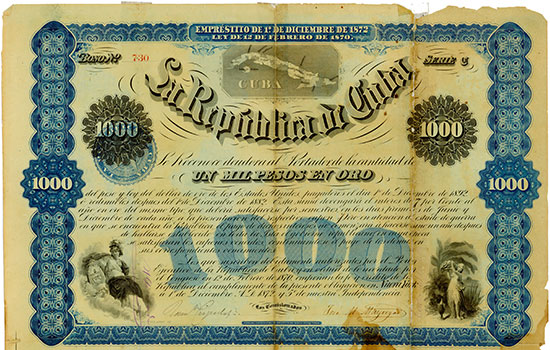Ingelsberg 17 b
D- 85604 Zorneding
Deutschland / Germany
Tel.: +49 (0)8106 - 2461-86
Fax: +49 (0)8106 - 2461-88
E-Mail: auktion@hwph.de
HWPH Historisches Wertpapierhaus AG –
Váš specialista na historické cenné papíry
a historii finančnictví
|
||||
Číslo |
1280 | |||
Titul |
Republica de Cuba | |||
Místo(a) |
New York | |||
Země |
Kuba | |||
Region |
Amerika | |||
Popis |
New York, 04.12.1872, 7 % Bono über 1.000 Pesos en Oro, Serie C, #730, 22 x 32,4 cm, blau, schwarz, blauer Stempel, Knickfalten und Einrisse teils alt geklebt, Randschäden, stark gebräunt, KB, drei Vignetten, eine davon mit einer Landkarte von Kuba. | |||
Popis (Angličtina) |
New York, 4 December 1872, 7 % Bond for 1,000 Goldpesos, Series C, #730, 22 x 32.4 cm, blue, black, blue stamp, folds and tears partially repaired with old tape, edge damage, tanned, coupons, three vignettes, one with a map of Cuba. | |||
Stav |
F | |||
 |
||||
Historie (Německo) |
Kuba war Mitte des 19. Jahrhunderts die letzte große spanische Kolonie. 1868 begann der 30jährige Kampf und die Unabhängigkeit mit dem Guerra Larga (großer Krieg) der bis 1878 dauerte. Am 10.10.1868 rief Carlos Manuel de Céspedes im Kriegsruf von Yara von der Ostprovinz Kubas Oriente aus das kubanische Volk zum Krieg gegen die Kolonialmacht Spanien auf. Mit einer kleinen Armee besetzte er die Stadt Bayamo. Als die Spanischen Truppen die Stadt zurückerobern wollten, zündeten die Bewohner die Häuser an und schlossen sich den Revolutionären an. Noch heute findet sich dieses Ereignis in der kubanischen Nationalhymne wieder: Sie entstand aus einem Gedicht, das dieses Ereignis feiert. José Morales Lemus führte in dieser Zeit die Revolutionisten in Havanna an. Durch die Platzierung der Anleihe in New York wurde der Widerstand finanziert. | |||
Historie (Angličtina) |
Cuba was the last big Spanish colony in the mid-19th century. The fight for independence, which was lasting for 30 years, began with the Guerra Larga (Big War) in 1868 which ceased in 1878. Carlos Manuel de Céspedes called up Cuba's people for war against the Spanish colonial power from Manzanillo on 10 October 1868. His little army occupied the city of Bayamo. The Spanish army tried to retake the city. But the townspeople set their houses on fire and joined the revolutionists. The Cuban national anthem encloses this incidence still today, it has its origin in a poem which celebrates this incident. José Morales Lemus was the leader of the revolutionists in Havana at that time. The floatation of this loan took place in New York for the purpose of financing the resistance movement. | |||
Povšimněte si prosím také nejlepších položek naší aukce: |
||||













